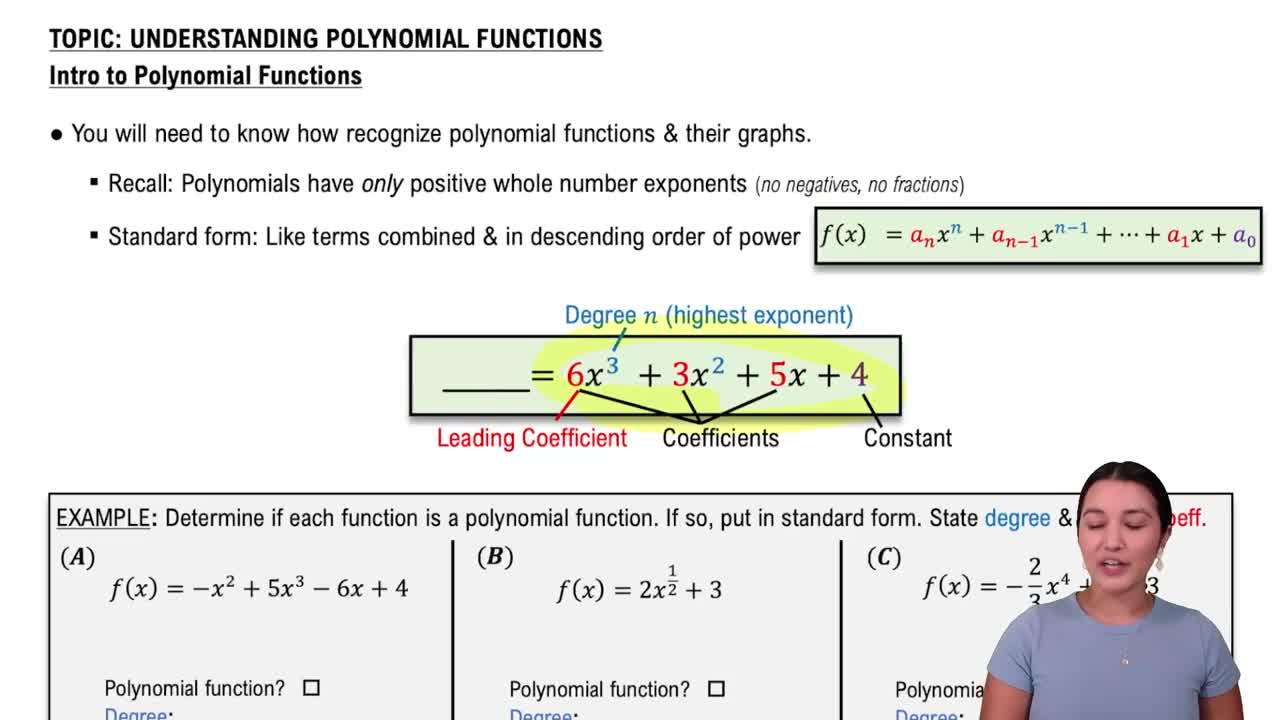Table of contents
- 0. Review of Algebra4h 16m
- 1. Equations & Inequalities3h 18m
- 2. Graphs of Equations43m
- 3. Functions2h 17m
- 4. Polynomial Functions1h 44m
- 5. Rational Functions1h 23m
- 6. Exponential & Logarithmic Functions2h 28m
- 7. Systems of Equations & Matrices4h 6m
- 8. Conic Sections2h 23m
- 9. Sequences, Series, & Induction1h 19m
- 10. Combinatorics & Probability1h 45m
3. Functions
Function Composition
Problem 21a
Textbook Question
For the pair of functions defined, find (ƒ/g)(x). Give the domain of each. See Example 2. ƒ(x)=2x^2-3x, g(x)=x^2-x+3
 Verified step by step guidance
Verified step by step guidance1
Step 1: Understand that (ƒ/g)(x) represents the division of the function ƒ(x) by the function g(x), which is expressed as (ƒ/g)(x) = ƒ(x) / g(x).
Step 2: Substitute the given functions into the expression: (ƒ/g)(x) = (2x^2 - 3x) / (x^2 - x + 3).
Step 3: Identify the domain of the function (ƒ/g)(x). The domain consists of all real numbers except those that make the denominator zero.
Step 4: Set the denominator equal to zero and solve for x: x^2 - x + 3 = 0. Use the quadratic formula if necessary to find the values of x that are not in the domain.
Step 5: Conclude that the domain of (ƒ/g)(x) is all real numbers except the solutions found in Step 4, as these would make the denominator zero and the function undefined.
Recommended similar problem, with video answer:
 Verified Solution
Verified SolutionThis video solution was recommended by our tutors as helpful for the problem above
Video duration:
4mPlay a video:
Was this helpful?
Key Concepts
Here are the essential concepts you must grasp in order to answer the question correctly.
Function Division
Function division involves creating a new function by dividing one function by another. In this case, (ƒ/g)(x) means we take the function ƒ(x) and divide it by g(x). This operation requires understanding how to manipulate algebraic expressions and the implications of division, particularly regarding the domain of the resulting function.
Recommended video:

Multiplying & Dividing Functions
Domain of a Function
The domain of a function is the set of all possible input values (x-values) for which the function is defined. For rational functions, the domain is restricted by any values that make the denominator zero, as division by zero is undefined. Therefore, when finding the domain of (ƒ/g)(x), we must identify the values of x that make g(x) equal to zero and exclude them from the domain.
Recommended video:

Domain Restrictions of Composed Functions
Polynomial Functions
Polynomial functions are expressions that consist of variables raised to non-negative integer powers and their coefficients. In this question, both ƒ(x) and g(x) are polynomial functions. Understanding their structure helps in performing operations like addition, subtraction, multiplication, and division, as well as analyzing their behavior, such as finding roots and determining the domain.
Recommended video:

Introduction to Polynomial Functions

 4:56m
4:56mWatch next
Master Function Composition with a bite sized video explanation from Nick Kaneko
Start learningRelated Videos
Related Practice










